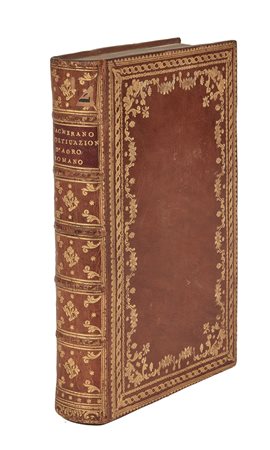 Il Ponte Casa d'Aste - Palazzo Crivelli - Via Pontaccio 12, 20121 Milano
Il Ponte Casa d'Aste - Palazzo Crivelli - Via Pontaccio 12, 20121 Milano
Asta N. 443 - Libri e Manoscritti Sessione Unica - dal lotto 1 al lotto 216
Tuesday 22 January 2019 hours 15:00 (UTC +01:00)
CACHERANO DI BRICHERASIO, Giovanni Francesco Maria (1736-1812) - De' mezzi...
CACHERANO DI BRICHERASIO, Giovanni Francesco Maria (1736-1812) - De' mezzi per introdurre, ed assicurare stabilmente la coltivazione e la popolazione nell'agro romano. Roma: Barbiellini alla Minerva, 1785.
Prima edizione su carta azzurra di quest'opera dedicata al pontefice che intendeva indicare una via pratica e sperimentale alla volontà di riforma ripetutamente dimostrata da Pio VI. Bisognava mutare del tutto il rapporto tra la città e la campagna, tra la capitale e le province. Roma era troppo grande, troppo popolata, priva di manifatture e di artigianato (troppo alto il costo della vita perché questo potesse svilupparsi) e viveva soltanto dei proventi dell'amministrazione, dei tribunali, del lusso. Lo Stato doveva incamerare almeno una parte dell'Agro romano, lottizzarlo, assumendosi il compito della bonifica e dell'insediamento (Treccani).
8vo (218 x 143mm). Incisione in legno al frontespizio, una tavola ripiegata e due tavole ripiegate incise in rame (manca l'errata C4, lievi tracce di polvere). Pelle coeva decorata in oro ai piatti, dorso e tagli, titolo su etichetta in marocchino rosso.
-EN
CACHERANO DI BRICHERASIO, Giovanni Francesco Maria (1736-1812) - De' mezzi per introdurre, ed assicurare stabilmente la coltivazione e la popolazione nell'agro romano. Rome: Barbiellini alla Minerva, 1785.
First edition on blue paper of this work dedicated to Pope Pio VI, with which Cacherano di Bricherasio outlines a practical and experimental way of the will of reform demonstrated by the Pope. The first part of the Treaty starts from the need to change the whole relationship between the city and the countryside: Rome was too big, too populous, without factories and craft and lived only of the administration proceeds, the courts , the luxury. This situation was greatly exacerbated by the fact that the surrounding area was "mal coltivato o affatto incolto". The State had to rake in at least part of the Agro Romano, dividing it, taking on the task of cleaning it up. The second part of the work is devoted to describing the villages that would be constructed, with their churches, their pastors and doctors, taken from Roman convents and hospitals, thus making them finally useful and active (Treccani).
8vo (218 x 143mm). Wooduct device on title, a folding table and two folding engraved plates (without errata on C4, some light soiling). Contemporary calf elaborately decorated in gilt on panels, spine and edges, red morocco spine label.

